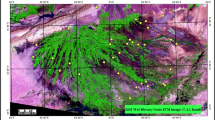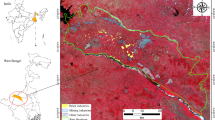Abstract
One of the major after effect of Bhuj Earthquake which occurred on January 26, 2001 was wide spread appearance of liquefaction of soil in the Rann of Kachchh and the coastal areas of Kandla port covering an area of more than tens of thousands of kilometers. Remote sensing data products allow us to explore the land surface parameters at different spatial scales. In this work, an attempt has been made to identify the liquefied soil area using conventional indices from IRS-1D temporal images. The same has been investigated and compared with Class Based Sensor Independent (CBSI) spectral indices, while applying fuzzy based noise classification as soft computing approach using supervised classification. Seven spectral indices have been investigated to identify liquefied soil areas using temporal multi-spectral images. The result shows that the temporal variations can be accounted by using appropriate remote sensing based spectral indices. It is found that CBSI based TNDVI using temporal data yields the best results for identification of liquefied soil areas, while CBSI based SR gives best results for water body identification.



Similar content being viewed by others
References
Binaghi, E., Brivio, P. A., Chessi, P., & Rampini, A. (1999). A fuzzy set based accuracy assessment of soft classification. Pattern Recognition Letters, 20, 935–948.
Birth, G. S., & McVey, G. (1968). Measuring the color of growing turf with a reflectance spectroradiometer. Agronomy Journal, 60(6), 640–643.
Brier, G. W. and Allen, R. A. (1951). In: T. Malone (ed.), Verification of weather forecasts, compendium of meteorology (pp. 841–848). American Meteorological Society.
Broge, N. H. and Leblanc, E. (2000). Comparing prediction power and stability of broadband and hyperspectral vegetation indices for estimation of green leaf area index and canopy chlorophyll density. Remote Sensing Environment, 76, 156–172.
Dave, R. N. (1991). Characterization and detection of noise in clustering. Pattern Recognition Letters, 12, 657–664.
Foody, G. M. (1996). Approaches for the production and evaluation of fuzzy land cover classifications from remotely sensed data. International Journal of Remote Sensing, 17(7), 1317–1340.
Hardisky, M. A., Klemas, V., & Smart, R. M. (1983). The influences of soil salinity, growth form, and leaf moisture on the spectral reflectance of Spartina alterniflora canopies. Photogrammetric Engineering and Remote Sensing, 49, 77–83.
Hazarika, H., & Boominathan, A. (2009). Liquefaction and ground failures during the 2001 Bhuj earthquake, India, Earthquake geotechnical case histories for performance-based design-Kokusho (ed) (pp. 201–225). London: Taylor & Francis Group.
Holzer, T. L. (1989). Dynamics of liquefaction during the 1987 Superstition Hills, California, earthquake. Science, 244(4900), 56–59.
Huete, A. R. (1988). A soil-adjusted vegetation index (SAVI). Remote Sensing of Environment, 25(3), 295–309.
Ishihara, K., Shimuzu, K., & Yamada, Y. (1981). Pore water pressures measured in sand deposits during an earthquake. Soils and Foundations (Japan), 21, 85–100.
Klir, G. J. (1990). A principle of uncertainty and information variance. International Journal of General Systems, 17(2–3), 249–275.
Kumar, A., Ghosh, S. K. and Dadhwal, V. K. (2006). A comparison of the performance of fuzzy algorithm versus statistical algorithm based sub-pixel classifier for remote sensing data, Proceedings of mid-term symposium ISPRS, 8–11th May 2006, ITC-The Netherlands.
Kumar, A., Ghosh, S. K., & Dadhwal, V. K. (2010). ALCM:Automatic land cover mapping. Journal of Indian Society of Remote Sensing, 38(2), 239–245.
Markham, B. L., & Barker, I. J. (1986). Landsat MSS and TM post-calibration dynamic ranges, exoatmospheric reflectances and at-satellite temperatures. EOSAT Landsat Technical Notes, 1, 3–8.
Miyamoto, S., Ichihashi, H. and Honda, K. (2008). Algorithms for fuzzy clustering, studies in fuzziness and soft computing (pp. 229 and 65–66). Springer.
Papadopoulos, G. A., & Lefkopoulos, G. (1993). Magnitude distance relations for liquefaction in soil from earthquakes. Bulletin of the Seismological Society of America, 83(3), 925–938.
Roeloffs, E. A. (1998). Persistent water level changes in a well near Parkfield, California, due to local and distant earthquakes. Journal of Geophysical Research, 103(B1), 869–889.
Rouse, J. W., Haas, R. H., Schell, J. A., and Deering, D. W. (1973). Monitoring vegetation systems in the Great Plains with ERTS, Third ERTS Symposium, NASA SP-351-I, 309–317.
Sarkar, I., & Chander, R. (2003). A simulation of earthquake induced undrained pore pressure changes with bearing on some soil liquefaction observations following the 2001 Bhuj earthquake. Proceedings of the Indian Academy of Sciences (Earth and Planetary Sciences), 112(3), 471–477.
Seed, H. B. (1970). Soil problems and soil behavior. In R. L. Wiegel (Ed.), Earthquake engineering (pp. 227–251). Englewood Cliffs, N.J.: Prentice Hall Inc.
Tucker, C. J. (1979). Red and photographic infrared linear combinations for monitoring vegetation. Remote Sensing of Environment, 8(2), 127–150.
Wang, F. (1990). Fuzzy supervised classification of remote sensing images. IEEE Transactions on Geoscience and Remote Sensing, 28(2), 194–201.
Zhang, J., & Foody, G. M. (1998). A fuzzy classification of sub-urban land cover from remotely sensed imagery. International Journal of Remote Sensing, 19(14), 2721–2738.
Acknowledgements
The authors are thankful to learned reviewers and Chief Editor, Journal of the Indian Society of Remote Sensing for their critical remarks, valuable guidance and comments in improving the manuscript.
Author information
Authors and Affiliations
Corresponding author
About this article
Cite this article
Sengar, S.S., Kumar, A., Ghosh, S.K. et al. Liquefaction Identification Using IRS-1D Temporal Indices Data. J Indian Soc Remote Sens 41, 355–363 (2013). https://doi.org/10.1007/s12524-012-0239-y
Received:
Accepted:
Published:
Issue Date:
DOI: https://doi.org/10.1007/s12524-012-0239-y




